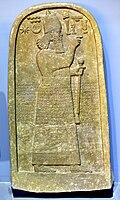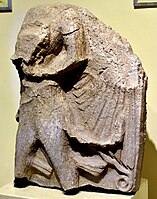Tell al-Rimah
Qatara/Karana (?) | |
 Shown within Iraq | |
| Location | Nineveh Province, Iraq |
|---|---|
| Region | Mesopotamia |
| Coordinates | 36°15′25.51″N 42°26′57.61″E / 36.2570861°N 42.4493361°ECoordinates: 36°15′25.51″N 42°26′57.61″E / 36.2570861°N 42.4493361°E |
| Type | tell |
| Site notes | |
| Excavation dates | 1964–1971 |
| Archaeologists | D. Oates |
Tell al-Rimah is a tell, or archaeological settlement mound, in Nineveh Province (Iraq). Its ancient name may have been either Karana or Qattara.[1] It is located in Nineveh Province (Iraq), roughly 80 kilometres (50 mi) west of Mosul and ancient Nineveh in the Sinjar region.
History of archaeological research[]
The region was originally surveyed by Seton Lloyd in 1938.[2] The site of Tell al-Rimah was excavated from 1964 to 1971 by a British School of Archaeology in Iraq team led by David Oates.[3][4][5][6][7][8] A large temple and palace from the early second millennium BCE were excavated, as well as a Neo-Assyrian building. Tell al-Rimah also is known for having a third millennium example of brick vaulting.[9]
Occupation history[]
While it appears that the site was occupied in the third millennium BCE, it reached its greatest size and prominence during the second millennium BCE and in the Neo-Assyrian period. The second millennium activity was primarily during the Old Babylonian and Mitanni periods. At various times, Tell al-Rimah has been linked with either Qatara or Karana, both cites known to be in that area during the second millennium.
Material culture[]
A number of Old Babylonian tablets contemporary with Zimri-Lim of Mari were found as well as other objects.[10][11][12] The most notable artifact found was the stele of Adad-nirari III which mentioned an early king of Northern Israel as "Jehoash the Samarian"[13][14] and contains the first cuneiform mention of Samaria by that name.[15]
Gallery[]

Stele of Adad-nirari III from Tell al Rimah, discovered in 1967, now in the Iraq Museum in Baghdad

Marble column from Tell al-Rimah, Iraq, Neo-Assyrian period. Iraq Museum

Limestone relief of a male figure from Tell al-Rimah, Iraq. Kassite period. Iraq Museum
See also[]
- Cities of the ancient Near East
- Short chronology timeline
References[]
- ^ Mckee, G. "Places: 356369838 (Qattara?/Karana?)". Pleiades. Retrieved June 26, 2017.
- ^ Seton Lloyd, Some Ancient Sites in the Sinjar district, Iraq, vol. 5, pp. 123ff, 1938
- ^ David Oates, The Excavations at Tell al Rimah: 1964, Iraq, vol. 27, no. 2, pp. 62-68, 1965
- ^ David Oates, The Excavations at Tell al Rimah, 1965, Iraq, vol. 28, no. 2, pp. 122-139, 1966
- ^ David Oates, The Excavations at Tell al Rimah, 1966, Iraq, vol. 29, no. 2, pp. 70-96, 1967
- ^ David Oates, The Excavations at Tell al Rimah: 1967, Iraq, vol. 30, no. 2, pp. 115-138, 1968
- ^ David Oates, The Excavations at Tell al Rimah, 1968, Iraq, vol. 32, no. 1, pp. 1-26, 1970
- ^ David Oates, The Excavations at Tell al Rimah: 1971, Iraq, vol. 34, no. 2, pp. 77-86, 1972
- ^ Barbara Parker, Cylinder Seals from Tell al Rimah, Iraq, vol. 37, no. 1, pp. 21-38, 1975
- ^ H. W. F. Saggs, The Tell al Rimah Tablets: 1965, Iraq, vol. 30, vo. 2, pp. 154-174, 1968
- ^ D. J. Wiseman, The Tell al Rimah Tablets: 1966, Iraq, vol. 30, no. 2, pp. 175-205, 1968
- ^ Stephanie Page, The Tablets from Tell Al-Rimah 1967: A Preliminary Report, Iraq, vol. 30, no. 1, pp. 87-97, 1968
- ^ William H. Shea, Adad-Nirari III and Jehoash of Israel, Journal of Cuneiform Studies, vol. 30, no. 2, pp. 101-113, 1978
- ^ Tell al-Rimah Stela (797 BCE): inscription by Assyrian king Adad-Nirari III, in which he describes his successes in the west. Livius.org. Quote: "...[4] I received 2,000 talents of silver, 1,000 talents of copper, 2,000 talents of iron, 3,000 linen garments with multicolored trim - the tribute of Mari' - of the land of Damascus. I received the tribute of Jehoash the Samarian, of the Tyrian ruler and of the Sidonian ruler."
- ^ Page, Stephanie (1968). "A Stela of Adad-nirari III and Nergal-ereš from Tell al Rimah". Iraq. 30 (2): 139–153. doi:10.2307/4199848. JSTOR 4199848.
Further reading[]
- Carolyn Postgate, David Oates and Joan Oates, The Excavations at Tell al Rimah: The Pottery, Aris & Phillips, 1998, ISBN 0-85668-700-6
- Stephanie Dalley, C.B.F Walker and J.D. Hawkins. The Old Babylonian Tablets from Al-Rimah, British School of Archaeology in Iraq, 1976, ISBN 0-903472-03-1
- Stephanie Dalley, Mari and Karana: Two Old Babylonian Cities, Gorgias Press, 2002 ISBN 1-931956-02-2
- C. B. F. Walker, A Foundation-Inscription from Tell al Rimah, Iraq, vol. 32, no. 1, pp. 27–30, 1970
- J. N. Postgate, A Neo-Assyrian Tablet from Tell al Rimah, Iraq, vol. 32, no. 1, pp. 31–35, 1970
- Stephanie Dalley, Old Babylonian Trade in Textiles at Tell al Rimah, Iraq, vol. 39, no. 2, pp. 155–159, 1977
- Joan Oates, Late Assyrian Temple Furniture from Tell al Rimah, Iraq, vol. 36, no. 1/2, pp. 179–184, 1974
- Barbara Parker, Middle Assyrian Seal Impressions from Tell al Rimah, Iraq, vol. 39, no. 2, pp. 257–268, 1977
- Jesper Eidem, Some Remarks on the Iltani Archive from Tell al Rimah, Iraq, vol. 51, pp. 67–78, 1989
External links[]
- Archaeological sites in Iraq
- Former populated places in Iraq
- Nineveh Governorate



